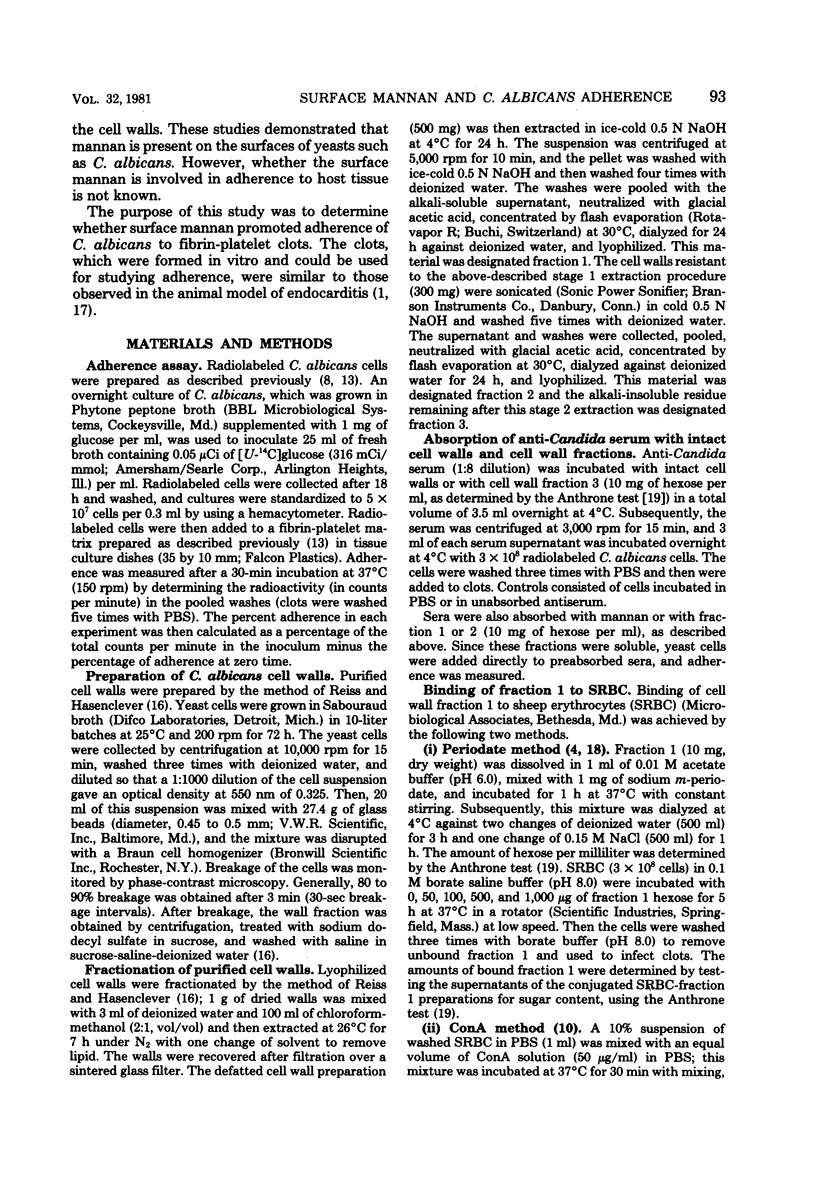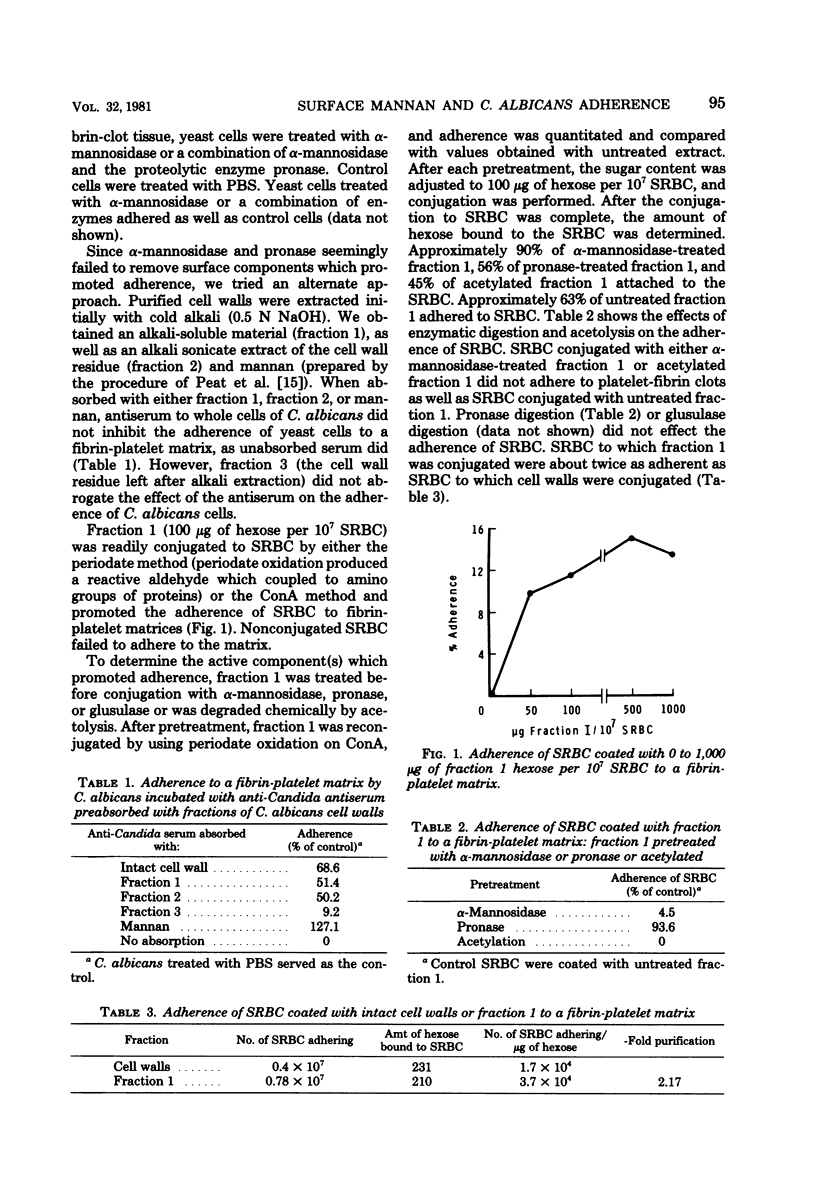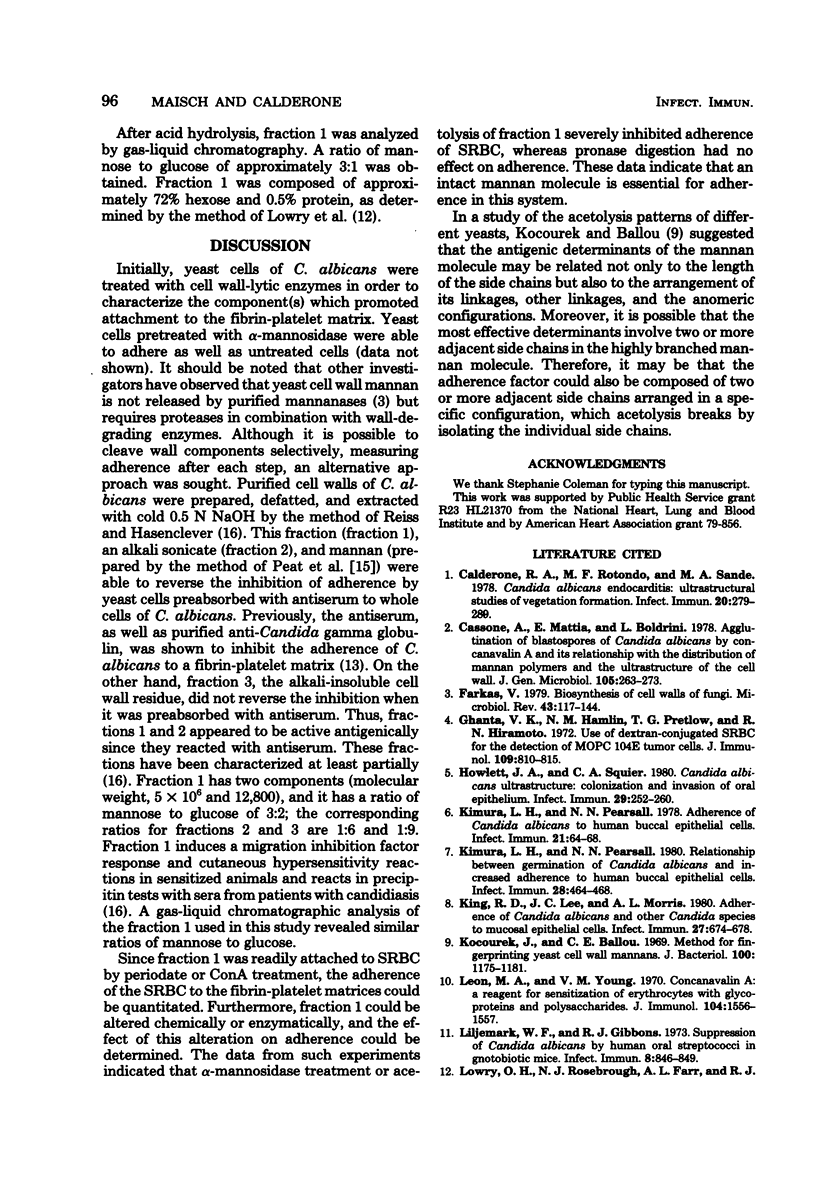Abstract
An alkali-soluble extract from a cell wall preparation of Candida albicans was conjugated to sheep erythrocytes (SRBC) by using periodate oxidation or concanavalin A. Conjugated SRBC readily attached to a fibrin-platelet matrix, whereas nonconjugated SRBC did not. To determine the active component which promoted attachment of SRBC, the alkali-soluble fraction was treated with alpha-mannosidase, pronase, or glusulase or chemically degraded by acetolysis. The treated extract was then reconjugated with SRBC, and attachment was measured. When treated with alpha-mannosidase or degraded by acetolysis, the alkali-soluble extract failed to promote the adherence of SRBC to the fibrin-platelet matrix. Pronase- or glusulase-digested extract promoted attachment equally as well as untreated controls. In addition, when preabsorbed with antiserum to whole cells of C. albicans, the alkali extract abrogated the inhibition of adherence by antiserum, thus indicating its antigenicity. The extract consisted primarily of polysaccharide (72%) and contained a small amount of protein (less than 1%). Mannose and glucose (ratio, 3:1) were detected by gas-liquid chromatography. These data indicate that cell surface mannan may play an important role in the adherence of C. albicans to the fibrin-platelet matrices which form in vivo on the endocardium of heart valves.
Full text
PDF





Selected References
These references are in PubMed. This may not be the complete list of references from this article.
- Calderone R. A., Rotondo M. F., Sande M. A. Candida albicans endocarditis: ultrastructural studies of vegetation formation. Infect Immun. 1978 Apr;20(1):279–289. doi: 10.1128/iai.20.1.279-289.1978. [DOI] [PMC free article] [PubMed] [Google Scholar]
- Cassone A., Mattia E., Boldrini L. Agglutination of blastospores of Candida albicans by concanavalin A and its relationship with the distribution of mannan polymers and the ultrastructure of the cell wall. J Gen Microbiol. 1978 Apr;105(2):263–273. doi: 10.1099/00221287-105-2-263. [DOI] [PubMed] [Google Scholar]
- Farkas V. Biosynthesis of cell walls of fungi. Microbiol Rev. 1979 Jun;43(2):117–144. doi: 10.1128/mr.43.2.117-144.1979. [DOI] [PMC free article] [PubMed] [Google Scholar]
- Ghanta V. K., Hamlin N. M., Pretlow T. G., Hiramoto R. N. Use of dextran-conjugated SRBC for the detection of MOPC 104E tumor cells. J Immunol. 1972 Oct;109(4):810–815. [PubMed] [Google Scholar]
- Howlett J. A., Squier C. A. Candida albicans ultrastructure: colonization and invasion of oral epithelium. Infect Immun. 1980 Jul;29(1):252–260. doi: 10.1128/iai.29.1.252-260.1980. [DOI] [PMC free article] [PubMed] [Google Scholar]
- Kimura L. H., Pearsall N. N. Adherence of Candida albicans to human buccal epithelial cells. Infect Immun. 1978 Jul;21(1):64–68. doi: 10.1128/iai.21.1.64-68.1978. [DOI] [PMC free article] [PubMed] [Google Scholar]
- Kimura L. H., Pearsall N. N. Relationship between germination of Candida albicans and increased adherence to human buccal epithelial cells. Infect Immun. 1980 May;28(2):464–468. doi: 10.1128/iai.28.2.464-468.1980. [DOI] [PMC free article] [PubMed] [Google Scholar]
- King R. D., Lee J. C., Morris A. L. Adherence of Candida albicans and other Candida species to mucosal epithelial cells. Infect Immun. 1980 Feb;27(2):667–674. doi: 10.1128/iai.27.2.667-674.1980. [DOI] [PMC free article] [PubMed] [Google Scholar]
- Kocourek J., Ballou C. E. Method for fingerprinting yeast cell wall mannans. J Bacteriol. 1969 Dec;100(3):1175–1181. doi: 10.1128/jb.100.3.1175-1181.1969. [DOI] [PMC free article] [PubMed] [Google Scholar]
- LOWRY O. H., ROSEBROUGH N. J., FARR A. L., RANDALL R. J. Protein measurement with the Folin phenol reagent. J Biol Chem. 1951 Nov;193(1):265–275. [PubMed] [Google Scholar]
- Leon M. A., Young N. M. Concanavalin A: a reagent for sensitization of erythrocytes with glycoproteins and polysaccharides. J Immunol. 1970 Jun;104(6):1556–1557. [PubMed] [Google Scholar]
- Maisch P. A., Calderone R. A. Adherence of Candida albicans to a fibrin-platelet matrix formed in vitro. Infect Immun. 1980 Feb;27(2):650–656. doi: 10.1128/iai.27.2.650-656.1980. [DOI] [PMC free article] [PubMed] [Google Scholar]
- Montes L. F., Wilborn W. H. Ultrastructural features of host-parasite relationship in oral candidiasis. J Bacteriol. 1968 Oct;96(4):1349–1356. doi: 10.1128/jb.96.4.1349-1356.1968. [DOI] [PMC free article] [PubMed] [Google Scholar]
- Reiss E., Stone S. H., Hasenclever H. F. Serological and cellular immune activity of peptidoglucomannan fractions of Candida albicans cell walls. Infect Immun. 1974 May;9(5):881–890. doi: 10.1128/iai.9.5.881-890.1974. [DOI] [PMC free article] [PubMed] [Google Scholar]
- Sande M. A., Bowman C. R., Calderone R. A. Experimental Candida albicans endocarditis: characterization of the disease and response to therapy. Infect Immun. 1977 Jul;17(1):140–147. doi: 10.1128/iai.17.1.140-147.1977. [DOI] [PMC free article] [PubMed] [Google Scholar]
- Sanderson C. J., Wilson D. V. Methods for coupling protein or polysaccharide to red cells by periodate oxidation. Immunochemistry. 1971 Feb;8(2):163–168. doi: 10.1016/0019-2791(71)90236-9. [DOI] [PubMed] [Google Scholar]
- Stoddart R. W., Herbertson B. M. The use of lectins in the detection and identification of human fungal pathogens. Biochem Soc Trans. 1977;5(1):233–235. doi: 10.1042/bst0050233. [DOI] [PubMed] [Google Scholar]
- Tkacz J. S., Cybulska E. B., Lampen J. O. Specific staining of wall mannan in yeast cells with fluorescein-conjugated concanavalin A. J Bacteriol. 1971 Jan;105(1):1–5. doi: 10.1128/jb.105.1.1-5.1971. [DOI] [PMC free article] [PubMed] [Google Scholar]


